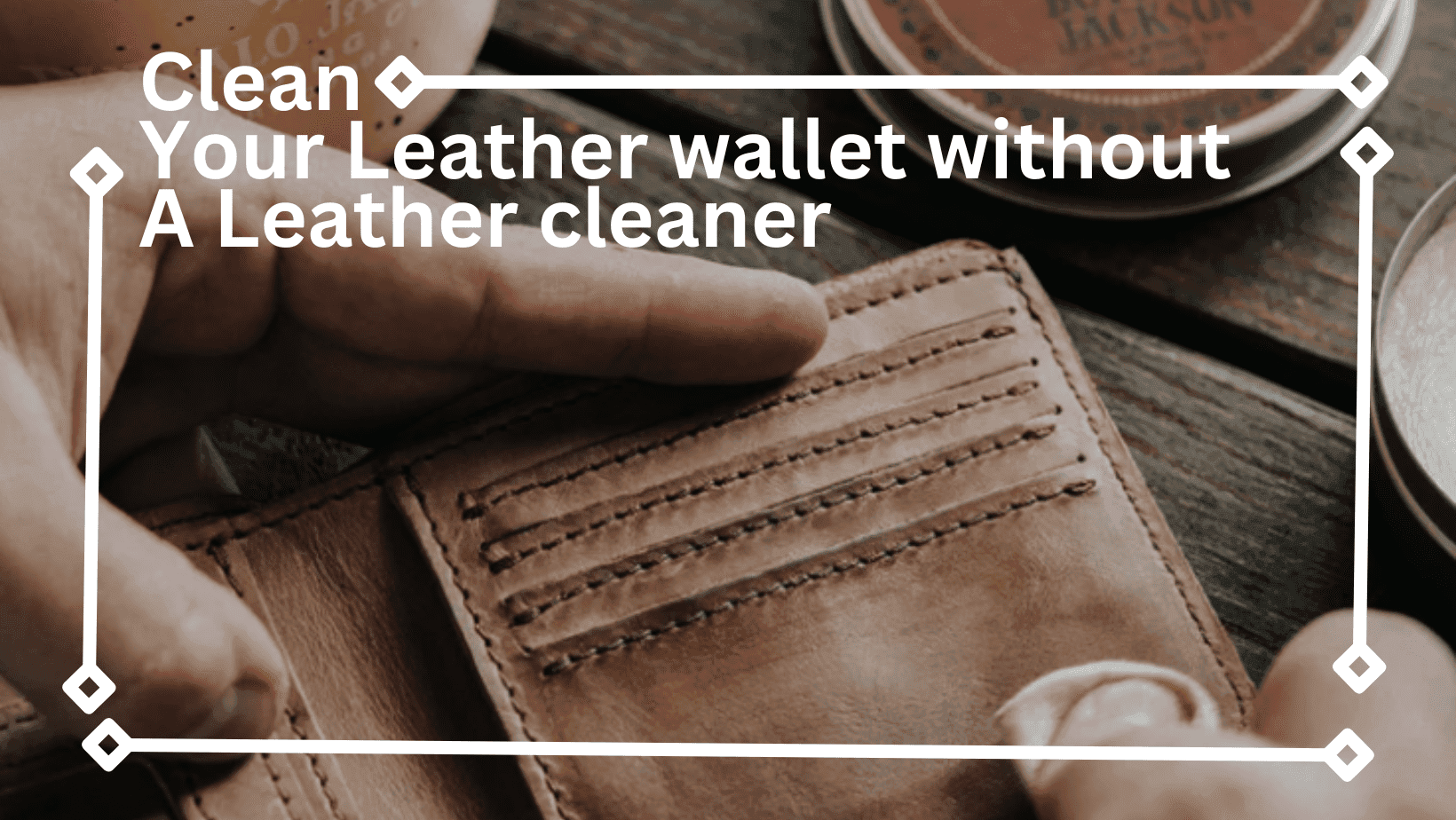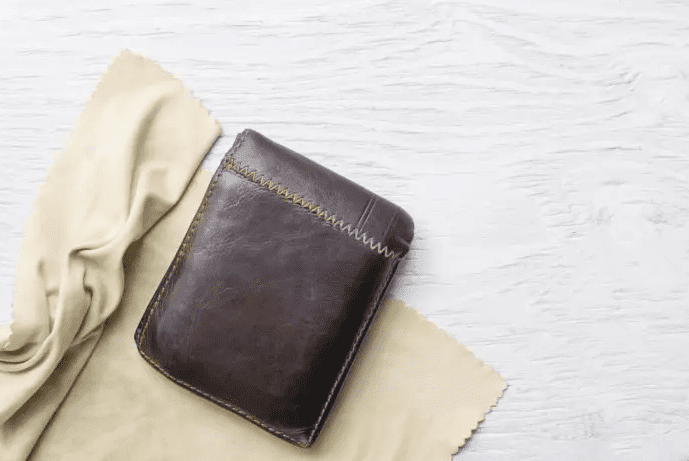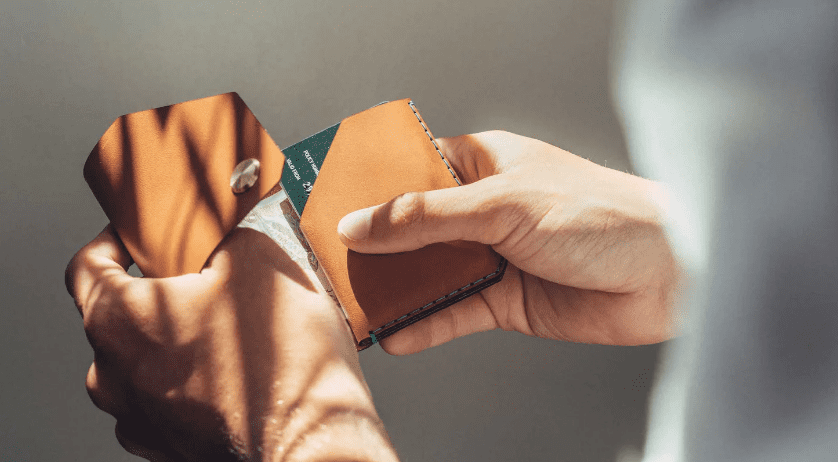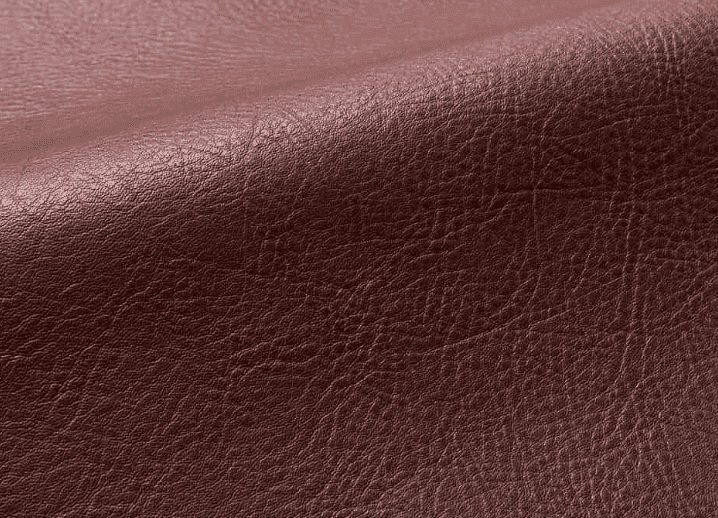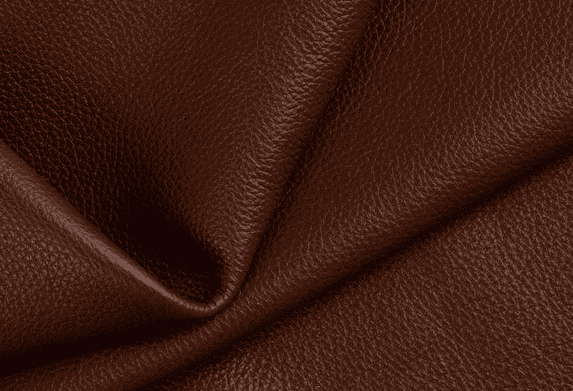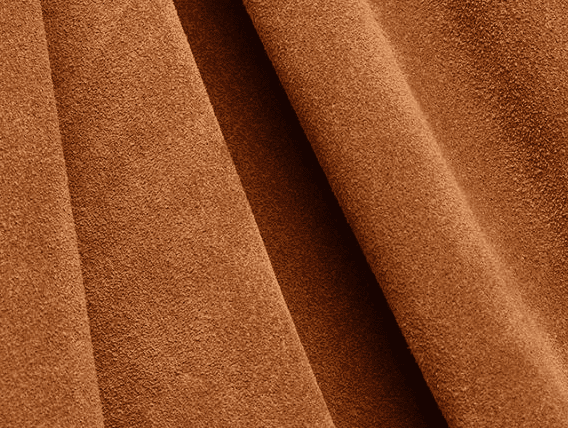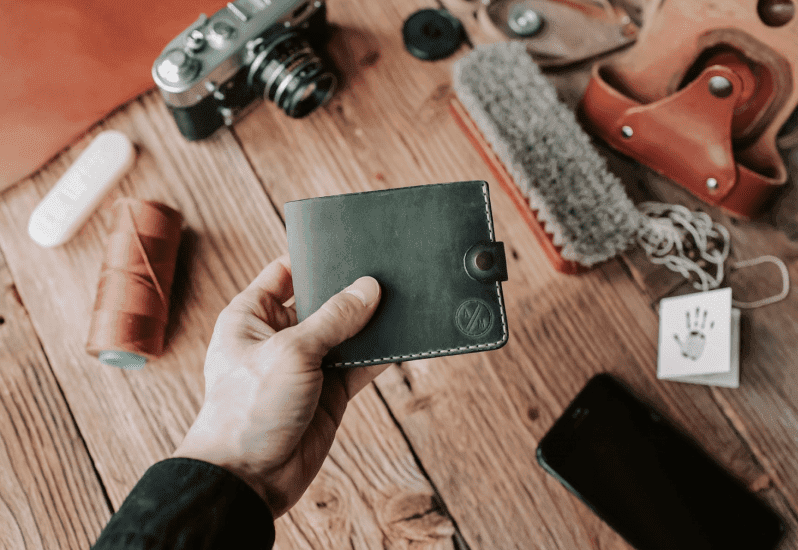Looking to learn how to clean your leather wallet perfectly without a leather cleaner? Read this detailed guide for in-depth directions.
Leather wallets are timeless accessories that exude elegance and style. They are not only functional in holding your cards and cash but also serve as a fashion statement. However, over time, leather wallets can accumulate dirt, stains, and oils from your hands, which can affect their appearance.
What You Need to Clean Your Leather Wallet Properly
Keeping your wallet in great condition starts with understanding how to clean your leather wallet safely. The best method is to use a soft cloth with a small amount of mild soap and water—never soak the leather, as too much water can cause damage. Yes, diluted Dawn dish soap can work if used sparingly. The same gentle approach applies to leather purses: wipe, dry naturally, and finish with a leather conditioner to maintain softness.
While commercial leather cleaners are available, there are several effective and wallet-friendly methods you can use to clean your leather wallet without the need for specialized products. In this comprehensive guide, we will walk you through the step-by-step process of cleaning your leather wallet and restoring its original luster.
To Clean Your Leather Wallet Gather Your Supplies.
Before you begin the cleaning process, it’s essential to gather the necessary supplies. You’ll need:
– Mild Soap: Opt for a gentle, pH-balanced soap such as castile soap or baby shampoo.
– Distilled Water: Using distilled water helps prevent minerals from leaving stains on the leather.
– Soft Cloths: Choose soft, lint-free cloths to avoid scratching the leather surface.
– Cotton Swabs: These are useful for reaching tight corners and seams.
– Isopropyl Alcohol: It’s effective for removing stubborn stains and disinfecting.
– White Vinegar: This natural cleaner helps eliminate odors.
– Leather Conditioner: To restore moisture and suppleness after cleaning.
Step-by-Step Cleaning Guide
Step 1: Prepare the Leather
Begin by gently emptying your wallet and shaking out any loose debris. This will make the cleaning process more effective. Open all the compartments and pockets to ensure you clean every nook and cranny.
Step 2: Test in an Inconspicuous Area
Before you proceed with cleaning the entire wallet, perform a patch test in an inconspicuous area. This will help you ensure that the cleaning solution doesn’t damage or discolor the leather.
Step 3: Remove Surface Dirt
Dampen a soft cloth with distilled water and gently wipe down the wallet’s surface. Focus on areas with visible dirt or stains. Avoid using excessive water, as leather is sensitive to moisture.
Step 4: Prepare the Cleaning Solution
Mix a small amount of mild soap with distilled water to create a cleaning solution. Moisten a cloth with the solution and wring it out to prevent excessive moisture. The cloth should be slightly damp, not soaking wet.
Step 5: Clean the Leather
Gently wipe down the entire surface of the wallet with the damp cloth. Use circular motions and apply light pressure. For stubborn stains, use cotton swabs dipped in the cleaning solution to target specific areas.
Step 6: Remove Stains with Isopropyl Alcohol
If you encounter stubborn stains that the soap solution couldn’t remove, dip a cotton swab in isopropyl alcohol. Carefully rub the stain, and then wipe the area with a clean, damp cloth.
Step 7: Address Odors with Vinegar Solution
To eliminate any unwanted odors, create a mixture of equal parts white vinegar and water. Dampen a cloth with the solution and gently wipe down the wallet’s interior. The vinegar naturally neutralizes odors and evaporates quickly.
Step 8: Allow Drying
After cleaning, allow the wallet to air dry naturally in a cool, dry place. Avoid exposing it to direct sunlight or using heat sources, as this can cause the leather to crack or warp.
Step 9: Apply Leather Conditioner
Once the wallet is completely dry, apply a leather conditioner to restore its moisture and suppleness. Follow the manufacturer’s instructions for application.
Maintaining Your Leather Wallet
Regular maintenance is key to preserving the appearance and longevity of your leather wallet. Here are some tips to keep it in pristine condition:
Keep Away from Water
Avoid exposing your wallet to excessive moisture or water, as it can damage the leather.
Store Properly
When not in use, store your wallet in a cool, dry place, preferably in a dust bag or a breathable container.
Avoid Overstuffing
Overloading your wallet with cards and cash can lead to stretching and distortion of the leather.
Handle with Clean Hands
Ensure your hands are clean and free from oils before handling your wallet to prevent transferring dirt onto it.
Use a Soft Brush
For routine maintenance, gently brush the leather surface with a soft-bristled brush to remove dust and prevent buildup.
By following these steps and tips, you can effectively clean and maintain your leather wallet without the need for specialized leather cleaners. With a little care and attention, your wallet will continue to be a stylish and functional accessory for years to come.
Let’s delve deeper into the topic of cleaning and maintaining leather wallets without a leather cleaner and explore various types of leather commonly used for wallets and their unique care requirements. Additionally, here are more advanced tips for keeping your leather wallet in optimal condition.
Understanding Leather Types and Care
Leather comes in a variety of types, each with its own distinct characteristics and care needs. Understanding the type of leather your wallet is made from can help you tailor your cleaning and maintenance routine for the best results.
Full-Grain Leather
Full-grain leather is renowned for its natural, rugged beauty. It’s the topmost layer of the hide and retains the original grain and imperfections, making each piece unique. To clean a full-grain leather wallet, follow these steps:
1. Dust Removal
Use a soft-bristled brush or a lint-free cloth to gently remove dust and dirt from the surface.
2. Conditioning
Apply a high-quality leather conditioner to nourish the leather and maintain its suppleness. This type of leather benefits from conditioning every few months.
Top-Grain Leather
Top-grain leather is slightly sanded and treated to remove imperfections, resulting in a smoother appearance. It’s durable and commonly used for wallets. Care for top-grain leather as follows:
1. Regular Cleaning
Wipe the surface with a damp cloth to remove dirt. Avoid excessive moisture, and always allow the wallet to air dry.
2. Conditioning
Apply a leather conditioner to prevent drying and cracking. Conditioning every six months can help maintain the leather’s quality.
Suede Leather
Suede leather has a soft, velvety surface created by buffing the underside of the hide. It’s susceptible to stains and requires delicate care:
1. Brushing
Use a suede brush or a clean toothbrush to gently brush away surface dirt and restore the nap.
2. Stain Removal
For stubborn stains, use a suede eraser or a mixture of equal parts white vinegar and water on a cloth. Blot the stain gently, then let it dry.
Patent Leather
Patent leather is coated with a glossy finish, giving it a distinct shine. While it’s less prone to stains, it requires specific care:
1. Wipe Clean
Use a damp cloth to wipe off dust and residue. Avoid using excessive water to prevent damage to the patent finish.
2. Polishing
Apply a patent leather conditioner or a small amount of mineral oil to maintain the shine and prevent cracking.
Advanced Tips for Leather Wallet Maintenance
Beyond the basic cleaning steps, there are additional measures you can take to ensure your leather wallet remains in excellent condition for years to come:
Avoid Extreme Temperatures
Leather is sensitive to extreme temperatures. Keep your wallet away from direct sunlight, heaters, radiators, and air conditioning vents. Exposure to heat or cold can cause the leather to dry out, crack, or warp.
Extreme temperatures can have significant effects on leather wallets, potentially causing damage that affects both the appearance and longevity of the accessory. Leather is a natural material, and its susceptibility to temperature changes stems from its organic composition. Here’s a closer look at the effects of extreme temperatures on leather wallets.
High Temperatures
Drying Out
Exposing leather wallets to high temperatures, such as leaving them in a hot car or near a heater, can cause the leather to dry out. Leather contains natural oils that keep it supple and prevent it from becoming brittle. High heat accelerates the evaporation of these oils, leading to a loss of moisture. As a result, the leather can become stiff, crack, and lose its natural luster.
Color Fading
Prolonged exposure to sunlight or heat can cause the color of the leather to fade over time. The pigments and dyes used to color leather are susceptible to UV radiation, which can break down the color molecules. This can result in a loss of vibrancy and richness in the wallet’s color.
Warping and Distortion
Extreme heat can cause leather wallets to warp, especially if they are stored in a position where pressure is applied unevenly. For instance, if a wallet is placed in a tight pocket while exposed to high heat, the leather can become misshapen and lose its original form.
Low Temperatures
Stiffening
Just as high temperatures can dry out leather, extremely cold temperatures can also have a negative impact. Cold air can cause the leather to stiffen, making it less pliable and more susceptible to cracking or tearing when flexed.
Moisture Absorption
Cold weather often brings with it moisture, and leather is known to absorb water. When leather absorbs moisture, it becomes heavy and soggy. Upon freezing, the absorbed water can expand, potentially causing the leather to stretch, distort, or even crack as the ice crystals form.
Reduced Flexibility
Low temperatures can reduce the natural flexibility of leather, making it more difficult to bend or fold. This can be especially problematic if you frequently handle your wallet, as it may not conform to your movements as effectively.
Prevent Color Transfer
Be cautious when placing your wallet on surfaces that may have dye or color residues, such as denim or dyed fabrics. Color transfer can occur and stain your wallet. If color transfer does occur, gently clean the affected area with a damp cloth and allow it to air dry.
Rotate Your Wallet
Using the same wallet every day can lead to uneven wear and tear. Consider rotating between a few different wallets to extend their lifespan.
Storage Matters
When not in use, store your wallet in a dust bag or a breathable container to protect it from dust and potential scratches. Avoid overcrowding the storage space to prevent unnecessary pressure on the wallet.
Properly storing your leather wallets is crucial to maintaining their quality and appearance over time. Leather is a natural material that can be sensitive to environmental factors. Storing your wallets in a controlled environment away from direct sunlight, extreme temperatures, and humidity helps prevent damage such as fading, cracking, or warping. Using a dust bag or a breathable container prevents dust buildup and potential scratches.
Overstuffing your wallet or storing it in a cramped space can lead to distortion and uneven wear. By treating your leather wallets with care and providing them with appropriate storage space, you ensure that they remain not only functional but also continue to exude the elegance and style that make them cherished accessories.
Professional Cleaning
If your leather wallet requires extensive cleaning or restoration, consider seeking professional help from a reputable leather care specialist. They have the expertise and tools to treat specific issues and rejuvenate the leather.
Opting for professional leather wallet cleaning services can be a worthwhile investment for those who value the longevity and pristine condition of their leather accessories. While DIY methods are effective to an extent, professional services offer a level of expertise and care that can rejuvenate and extend the life of your wallet.
These services often use specialized techniques, quality products, and in-depth knowledge of different leather types to ensure optimal cleaning and conditioning. For vintage or high-end leather wallets, where the risk of damage is higher, professional cleaning can provide peace of mind.
Additionally, professional cleaners can tackle complex stains, odors, and wear that might be challenging to address at home. Ultimately, the decision depends on your wallet’s value and your commitment to preserving its original charm.
Conclusion on how to clean leather wallet.
Caring for your leather wallet without a leather cleaner is entirely feasible, regardless of the type of leather it’s made from. With a combination of regular cleaning, conditioning, and cautious storage, you can maintain the beauty and longevity of your leather wallet.
Remember to tailor your care routine to the specific type of leather you have, and always prioritize gentle methods to prevent damage. By following these advanced tips and techniques, you’ll ensure that your leather wallet continues to be a cherished accessory for years to come.

